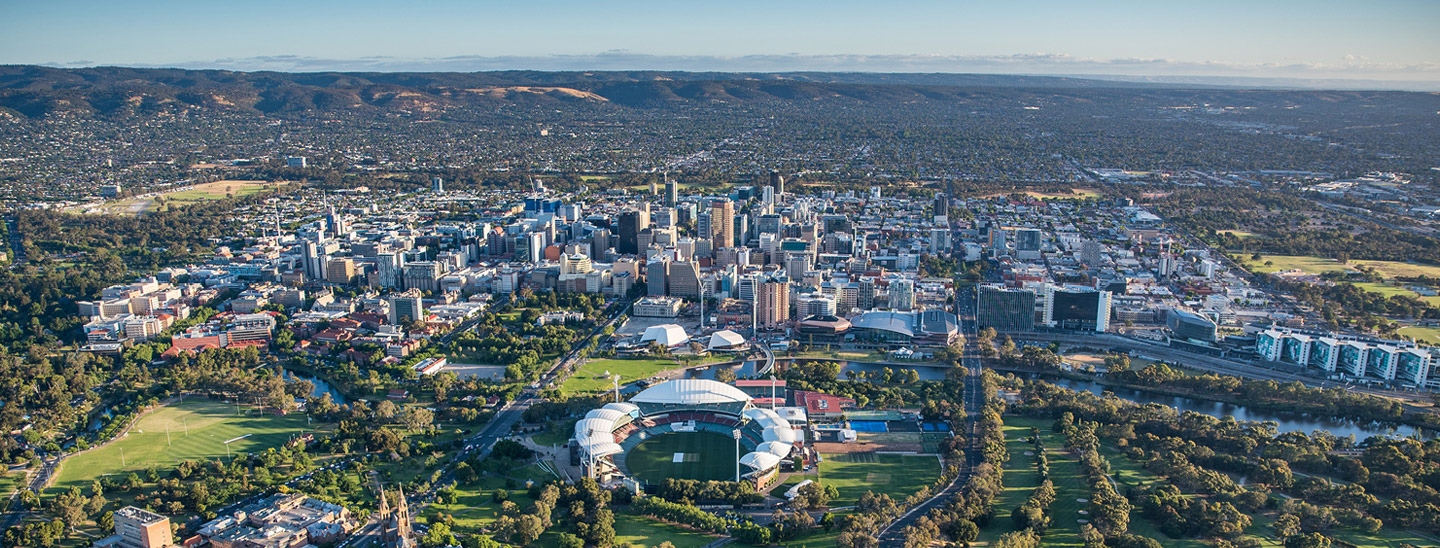
Eynesbury College was established on 1 October 1989 in the historic Eynesbury House at 69 Belair Road, Kingswood, South Australia. The college was the first senior secondary school in the state to offer Year 11 and 12 courses to full fee paying domestic and international students, with an English Language Centre. The first program of English Language Intensive Courses for Overseas Students (ELICOS) commenced in November 1989. The foundation intake of Year 11 and Year 12 students began studies on 22 January 1990.
Eynesbury offered an innovative and distinctive model of teaching and learning. The model emphasised the importance of teaching with minimal administrative bureaucracy, where teachers exercised a high level of autonomy and input into college decision-making. Students engaged with teachers in student-teacher partnerships, in an adult learning environment, where the emphasis was on study skills and independent learning.
Dimensions of the Eynesbury model have since been adopted by virtually every public, independent, and non-secular school, in South Australia, ensuring an enduring legacy. But this is only part of the bigger picture of Eynesbury. The senior secondary school was integral to the formation of innovative public-private sector relationships between the umbrella company of Eynesbury and the university sector.
In November 2021 (after some 32 years), Eynesbury Senior College (for domestic students) and the senior secondary component of Eynesbury College (for international students) were closed, amidst ongoing financial fall-out from the Covid pandemic. Eynesbury College nevertheless continued, with the Eynesbury College Academy of English (ELICOS) and a university Foundation Studies Program (FSP) for international students. The College also became the provider of Higher Education (HE) diploma programs, previously delivered by the Eynesbury Institute of Business and Technology (EIBT).
The initial vision was for a private, specialist, pre-university, senior high school, with courses only for the final two years of post-compulsory education. The school would be independent, secular, non-denominational and co-educational. There would be an explicit pre-university focus, involving a different approach to teaching and learning, providing transitional steppingstones from school to university. Students would have more flexible timetables and longer lessons than other schools. They would study in a mature, adult learning environment, where the emphasis was on collegiate, teacher-student partnerships. Classes would be small, and pedagogy would focus on independent learning, supported by study and time management skills. Students would receive out-of-class tuition from teachers on a first name basis, with the absence of uniforms and younger students. Distinctively, the school would also have a significant proportion of overseas students.
The Eynesbury story really began in 1983, with the election of the Hawke Labour Government, and by 1985, Australian institutions were able to offer their courses overseas, in the major emerging markets of Malaysia, Indonesia, Singapore and Hong Kong.
By the mid 1980’s, Tasmania and the ACT had established senior secondary colleges, suited to the needs of students during the last two years of high school education, but there was no equivalent in South Australia.
In 1986, the founders of Eynesbury, Noel Guerin, Dr Anthony (Tony) Stimson and Malcolm Raedel, were colleagues at Kensington Park College of TAFE (Department of Technical and Further Education), Adult Matriculation School, where they experienced first-hand, the embryonic beginnings of international education in Australia.
Supported by wives, Dianne Guerin, Jan Baker and Deborah Raedel, the founders were also becoming increasingly alive to the potential for applying elements of the TAFE Adult Matriculation operation, to a younger, post compulsory, school-age cohort of students.
They believed that there should be a market for an independent, co-educational, secular, non-denominational school that was a senior college, just for Year 11 and Year 12 students, free from the distractions of younger students, without formal sporting programs and extra-curricular activities.
The College would also be a specialist pre-university college, only offering academic programs, involving Year 11 and publicly examined Year 12 subjects, for students who sought entry to, and success at, university.
The primary role would be to provide a bridge from a conventional school to tertiary studies, offering a learning environment that would encourage young adults to develop their full potential as scholars and as people. It would embrace a staff of specialist teachers, with an emphasis on academic excellence and the development of independent learning and study skills.
The College would be privately owned, self-funded and self-reliant, without support from a founding church, without external backers or investors, would not qualify for government funding and would pay taxes like any other proprietary limited company. Viability would be entirely dependent on tuition fees, which would be set in the low, middle range for Independent schools.
The timetable would be structured into two, two-hour classes per subject (rather than the common 35 or 40-minute periods in schools) and would extend over a longer school day (from 8.45am to 5.45pm), providing greater flexibility in time management and optimal subject choice. Students would only be required to attend classes for 20 hours per week. Outside of formal classes, students would manage their time in private study and receive one-to-one personal tuition from teachers as needed.
The vision was to attract students from a broad range of abilities who were ambitious, committed and prepared to work hard to develop their full academic potential. From the start Eynesbury was open to students who may not have fitted easily into more conventional schools.
The College would also have a significant proportion of international students, if successful in tapping into the emerging export education market being opened in the public and private sectors by the Australian Government.
High Schools at the time, occupied two ends of a spectrum:
No school had a substantial mix of both, but the international goal created significant additional challenges.
The founders would need to establish an English Language (ELICOS) Centre, to raise the level of English proficiency of most overseas students. They would need to develop a dedicated enrolment system that complied with evolving Government regulations for visa processing and fee payment. They would need to establish dedicated student welfare and support systems, including accommodation, such as home-stay. And most fundamentally, they would need to attract students through private agents in overseas markets.
In terms of management of the College, there would not be a single “Principal”, rather a “flat” structure, with three Directors or Co-Principals, each with defined areas of responsibility, to optimise expertise and potential for growth.
The founders brought the necessary experience and professional profiles to the roles of Directors and Co-Principals. (Noel Guerin was a former Chief Examiner in Mathematics 1 and 2 for the Public Examinations Board of South Australia, Tony Stimson was a former Supervising Examiner in Australian History for the Senior Secondary Assessment Board of South Australia, and Malcolm Raedel was a former Chief Examiner in Economics for the Senior Secondary Assessment Board of South Australia). Together, they would teach Mathematics, Economics, Accounting and History, providing the nucleus of an effective teaching unit.
To make any of this possible, however, the founders needed Registration from the Non-Government Schools Registration Board (NGSRB), the state accrediting body for Independent schools. They needed to persuade the Board that the project was likely to be viable, but most importantly, they needed registration that would accommodate the new world of international students and the need for an ELICOS centre.
The NGSRB operated on a two-year period for registration from time of the initial application to commencement of the new school, starting from 31 January in any year. The founders approached the Board in June 1987. That meant the earliest commencement date would be January 1990. This was problematic, in several regards:
The lead time for promotion of courses to overseas students was at least six months. But first, the founders had to identify and enter into commercial agreements with private agents, starting without history, students or record of success. The agents would then need time to promote the institution, complete the application and enrolment process, collect tuition fees, obtain student visas and confirm arrival details etc. Upon arrival, most students would need to complete an English language program (of variable length depending on the existing level of proficiency), prior to entering the High School.
By September 1988, Educational Enterprises Australia Pty Ltd (EEA) had been formed. Messrs Guerin, Stimson and Raedel became joint owners and Directors, with “Eynesbury College” the registered business name (initially “Eynesbury House Senior Secondary College”). Suitable premises had been identified and a lease was secured on “Eynesbury House”, from 1 October 1989.
The ensuing 12 months were a particularly challenging time, involving legal action, the Premier, the Minister of Education and the Ombudsman, but by March 1989, the College had been registered by the Non-Government Schools Registration Board of South Australia as an educational institution, with registration to be effective from 1 October 1989. The City of Mitcham had approved the use of Eynesbury House as an educational institution.
The founders had to apply to the Department of Employment, Education and Training (DEET), Canberra, for provisional accreditation as an ELICOS centre, and DEET would not act on accreditation until a licence had been awarded by the Office of Tertiary Education in South Australia.
Provisional accreditation was secured, and the first international foray was in April 1989, when Malcolm Raedel began the overseas promotion and recruitment. In the following seven months, the founders spent a total of 11 weeks, in virtually every potential market of importance in south Asia, southeast and northeast Asia.
On 1 October 1989, Eynesbury College was finally established.
Literally days later, the first intake of ELICOS students arrived from Hong Kong to start their English language program.
Following an Orientation Day on Friday 19 January 1990, Year 11 and Year 12 classes began on 22 January, a week earlier than other schools, to accommodate an Intensive Study Skills program in the ensuing weeks. Eynesbury College was underway, with 137 students (increasing to 145), including 28 from overseas, in Years 11 and 12.
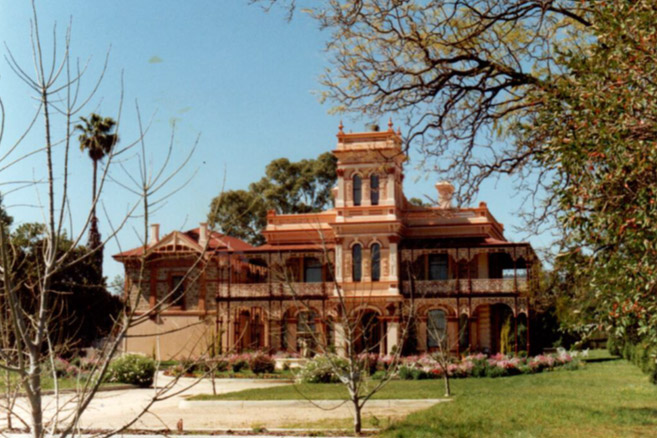
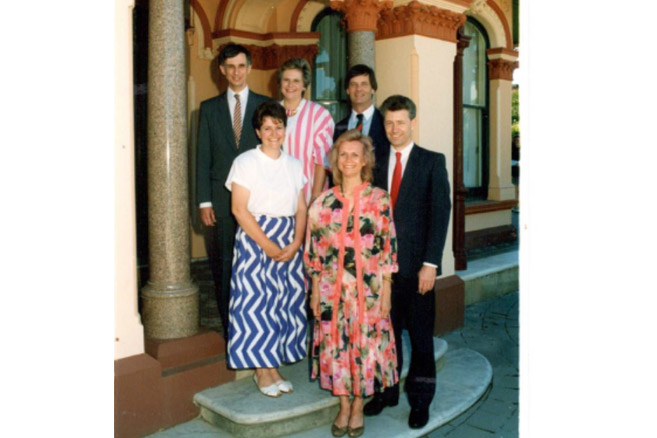
From top left to right: Dr Anthony Stimson, Di Guerin, Noel Guerin
Lower left to right: Jan Baker, Deborah Raedel, Malcolm Raedel
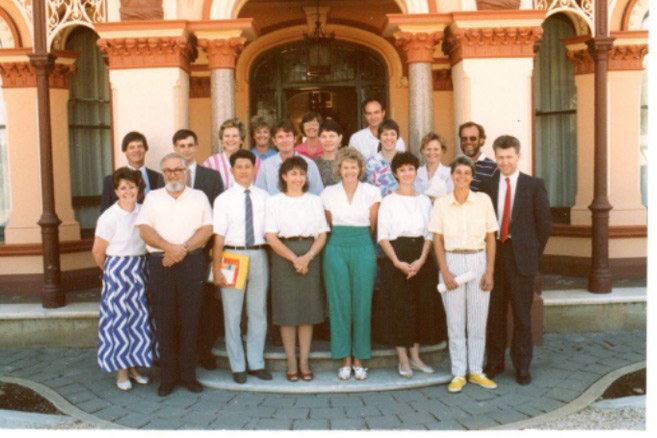
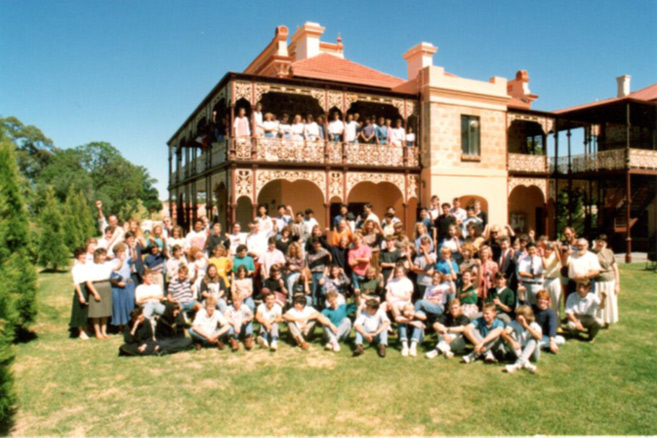
From the outset, the College attracted exceptional teachers from TAFE Adult Matric centres and the Independent and Government Schools sectors, many of whom were former deputies, seniors or heads of departments. Highly qualified, experienced and totally professional, teachers were specialists in their field, bringing a unique blend of expertise, passion and approachability to an adult learning environment. Unquestionably, they constituted one of the finest teaching teams in the state, where the relationship between student and teacher was much more important than physical resources.
For the financial year ending 30 June 1990, enrolments and revenue had exceeded expectations, but so too had expenses.
Additional income streams were needed, and the resources of the English Language Centre were used to:
During the year, an annex of the main campus was established in the Hawthorn Village, a few minutes’ walk from Eynesbury House, to be ready for occupancy at the beginning of the 1991 academic year.
Meanwhile the foundation intake of Year 12 students achieved a median Tertiary Entrance Ranking (TER) of close to 90 in the final examinations, setting the college an enviable benchmark for achieving outstanding academic results.
Many within the sector said that a privately owned, “for profit” school, founded at a time of the 1990/91 economic recession, wouldn’t work or last.
On the contrary, the pre-university model very quickly proved itself, as reflected by community support and enrolments, but the skeptics might well have been right, for a very different reason.
On 4 January 1991, a fire in the main building caused extensive damage to classrooms and offices, with the loss of specialised teaching resources in the English Language Centre.
Interestingly, just one year after commencement, The Advertiser led with … “One of Adelaide’s most prestigious schools burnt down”.
The founders literally had a couple of weeks to install transportable buildings in the rear garden and reassure the parent community that it was “business as usual”.
With the help of insurance, the school continued, and again the results achieved by Year 12 students in 1991 were outstanding, with 98 per cent of students achieving a Pass rate of ‘D’ or better.
As a fees-driven school, and as a school which had to attract a new cohort of students every year in the absence of a guaranteed flow-on from earlier year levels, Eynesbury had to be highly responsive to students and parents and could take nothing for granted. This unusual degree of accountability explained in no small measure the School’s immediate success in Adelaide.
Indeed, the academic profile was such that in 1991, the University of Adelaide (the third oldest university in Australia), approached Eynesbury to design and deliver the first “Foundation Studies Program (FSP)” in the state. The program was in effect an alternative to Year 12, tailored to the needs of full fee-paying international students.
In 1992, Eynesbury offered 16 PES publicly examined subjects (accepted by the universities) in Year 12 and 19 subjects for Year 11.
In January 1992, the College introduced a “Headstart program”, followed by “Holiday Revision Programs” conducted primarily by Eynesbury teaching staff, during the term 1, 2 and 3 holidays. The programs were designed to further improve students’ end of year performance and satisfied a broad, unfilled community demand.
In a couple of years, Eynesbury had grown to become one of the largest Year 12/Matriculation centres in the state. One third of students were “Year 13’s”, improving their score on Year 12, with 20 percent from overseas.
This was also the year of introduction of the “South Australian Certificate of Education (SACE)” and the Carmichael report to the Federal government. Laurie Carmichael argued that the senior school model offers the preferred environment in which to foster a greater sense of maturity and responsibility in young adults, with high levels of student satisfaction, and high staff morale. The conclusions and recommendations reflected the Eynesbury experience.
Come year’s end, the Pass rate (‘D’ or better) for Year 12 students was 98 percent and approximately two thirds of the grades obtained were at A or B level, with 26 perfect scores.
In 1992, Eynesbury College delivered the first Foundation Studies Program (FSP) on behalf of the University of Adelaide (and facilitated the first contract for the University with a “private” offshore agent, Hui & Kuah Pte Ltd, in Singapore). The program represented the beginning of long-term public-private sector relationships with the university sector.
From the outset, 98 per cent of FSP graduates entered tertiary institutions.
1993 saw enrolments stabilise at approximately 300 Year 12/13 and 70 Year 11 students.
Eynesbury House presented as a much scaled-down version of a traditional private school, but it was state heritage listed, and space to accommodate growth, was an on-going challenge.
As a partial solution, the Co-Principals gained approval from the City of Mitcham for an additional transportable building, with new rooms in the rear garden on the main campus, designed to blend in with the Victorian architecture of Eynesbury House.
In August 1993, Eynesbury entered into a close collaborative relationship with CALUSA (Centre for Applied Linguistics in the University of South Australia) and formed an exclusive relationship with the Swiss, International College of Hotel management (ICHM).
In the final examinations in 1993, Eynesbury students came top of the state in three subjects and equal top in two more. 75 per cent of all subject grades achieved by Eynesbury students in PES subjects were A or B grades, while 25 per cent of all students scored 60 or more scaled points out of a possible 70, and 77 per cent scored 50 or more out of 70.
In 1994, Flinders University and the University of South Australia (UniSA) joined with the University of Adelaide, to create a state-wide foundation program, known as the “South Australian Universities Foundation Studies’ Program”. This was a national first, where three universities agreed to an arrangement for which Eynesbury was the exclusive provider of pathways into separate faculties of each university. Students were guaranteed a place in their proposed degree course, subject to satisfactory completion of the FSP and the achievement of a score set by the relevant faculty. If a student was unsuccessful with their first choice, they were offered the next on their preference list.
Later, a longitudinal tracking exercise, undertaken for the period 1992 to 2006, confirmed that by July 2008:
By October 1994, Eynesbury had the largest enrolment of full fee-paying overseas students outside of the tertiary sector in South Australia. At any one time, there were some 170 students spread over three programs: 85 on average in the English Language (ELICOS) Centre; 50 in Senior Secondary (Years 11 and 12); and 35 in the Foundation Studies Program (FSP).
Eynesbury was already unique in the Australian context, as provider of both high school and foundation programs. Interstate institutions had one or the other, but not both.
By the beginning of 1995, the main campus at Kingswood was supplemented by two substantial annexes (Hawthorn Village and the Mitcham Shopping Centre) but was unable to accommodate future expansion. There were also concerns that Eynesbury lacked a central location for the whole of the metropolitan area of Adelaide, and international students had a clear preference for a central city location.
After a long and initially fruitless task, a new Adelaide campus was opened at 15-19 Franklin Street (diagonally opposite the GPO) in January 1996. The Adelaide campus represented a substantial financial investment and provided three times the combined area of Kingswood.
Noel Guerin remained at the Kingswood campus as Principal. Dr Tony Stimson became Principal of the local High School programs and Malcolm Raedel became Director and Principal of all international programs, now delivered at the City Campus.
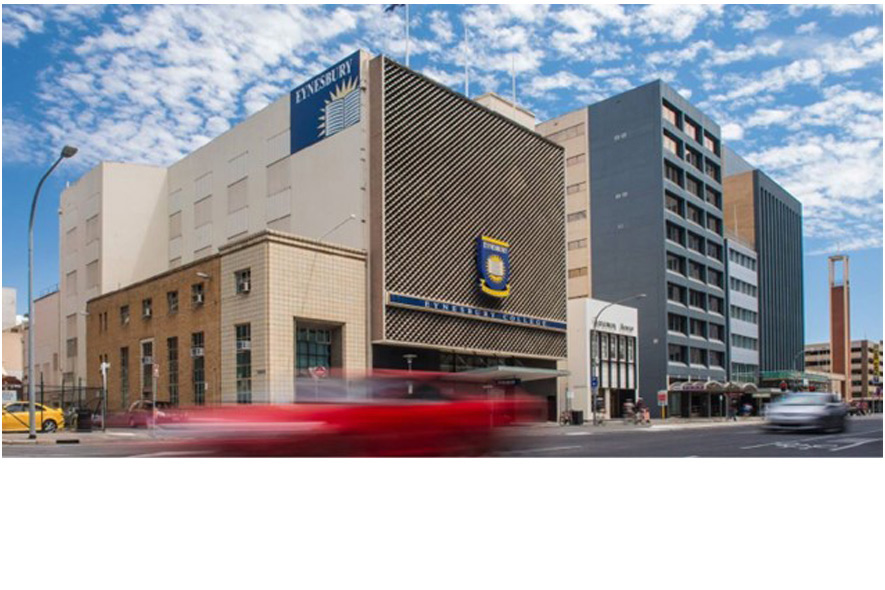
Eynesbury understood the importance of international partnerships in facilitating a stable, long-term pipeline of international high school students, and Eynesbury was one of the first Australian institutions to enter China, with the establishment of the China Australia Language College (CALC), in Changchun, Lin Province, North-eastern China.
From January 1996, Eynesbury introduced Year 10 for international students and in March 1996 commenced the English program conducted by CALC. Malcolm Raedel spent weeks at a time in China and the first group of students eventually entered Year 10 or Year 11 in June 1999. Unlike many Australia-China partnerships, Eynesbury was successful, both financially, and in the conversion rate of students.
By late 1996, there were increasing demands for the introduction of new information technologies and increasing costs of government compliance, and with changes in Government legislation, the Directors decided that it was time to restructure.
Eynesbury College Years 10, 11 and 12 Inc became a separate legal entity, a not-for-profit school with its own Constitution and governing Council. It was registered only to take Australian students, for whom it received per capita recurrent grants. The College was fortunate to attract Richard Smith as Chairman of the School Council, with support from Kingsley Purdie.
Eynesbury College continued as the school for overseas students.
Eynesbury formally became two schools which shared the costs of running the jointly operated Franklin Street campus. Where possible, and appropriate, Year 12 and Foundation students shared classes. It was the beginning of many mutually advantageous efficiencies in management and resource allocation for the affiliated entities.
In late 1995, Malcolm Raedel had a conversation with Rodney (Rod) Jones at an Education Exhibition in Kuala Lumpur, Malaysia, in which Mr Jones shared the story of the embryonic Perth Institute of Business and Technology (PIBT), established in association with Edith Cowan University (ECU). Along with Dr Peter Larsen, they had established a pathway which involved a Certificate IV Foundation, linked to entry into diplomas in Business and IT, based on Year 1 at ECU. Completion of the diploma was followed by “guaranteed” articulation into Year 2 of undergraduate degrees at ECU. Just as Eynesbury recognised that local students sometimes failed to realise their potential in a “traditional” school environment, the PIBT model recognised the high failure rate of international students in Year 1 of university.
A key feature of the PIBT pathway was location on a university campus. The teaching model involved a “block” timetable of 4 hours per subject per week, much more “personalised” teaching than typical of university lectures, with additional student support outside of class. Critically, the program was delivered on a trimester basis; an innovative and much more efficient model than the standard two semester system. With three semesters in a calendar year, there was greater opportunity for entry from countries with different education systems and examination dates, the opportunity for students to spread their study load over three semesters and still complete within the calendar year or complete the program faster.
Almost immediately, Malcolm Raedel found champions of the model in Peter Curnow and Mac Benoy at UniSA, along with Dr Frans Liefrink, the Director of CALUSA, before gaining the crucial support of Prof Kevin O’Brien (PVC Division of Business and Enterprise) and Prof Ian Davey (PVC International and Research), subsequently supported by Prof Denise Bradley (who became Vice Chancellor in 1997) and her Senior Management team.
In 1997, the Eynesbury Institute of Business and Technology (EIBT) was formed, and from 1998 delivered a Diplomas of Business and Diploma of IT, based on Year 1 of undergraduate programs at UniSA, with articulation into Year 2 at UniSA. The agreement was also concurrently concluded with Flinders University, facilitated by Prof Ian Chubb, the Vice Chancellor at Flinders, with entry into Year 2 (or the equivalent) at Flinders. Entry from a Pathway College into two universities represented another first, for Eynesbury.
In 1997, the Eynesbury College Academy of English (ECAE) Centre was created to deliver academic, general and specialised English language courses to international students.
By this stage, Eynesbury offered the most comprehensive choice of pathways to university of any single education provider in the country.
Later, articulation arrangements from EIBT were also established with the University of Adelaide.
By 1998, UniSA had decided that English language delivery was no longer core business of the University, and in June 1998, Educational Enterprises Australia Pty Ltd (EEA) took over the management of CALUSA under licence on the City East Campus of UniSA; the first such public-private sector relationship in the state. Malcolm Raedel became the executive Director.
In July 1998, Noel Guerin disposed of his share in the company. Malcolm Raedel became the Managing Director.
This was also the year in which EEA raised the prospect of an “Adelaide Institute of Business and Technology” with UniSA, to be co-located with CALUSA on the City East Campus.
In December 2000, Malcolm Raedel put a proposal to the Directors of the IBT Group, for the establishment of a Pathway college co-located with CALUSA, on the City East campus of UniSA.
In 2001, the “South Australian Institute of Business and Technology (SAIBT)” was established, adopting existing EIBT diplomas, with shared management from Eynesbury, but based on a university campus, as per Perth Institute of Business and Technology (PIBT), Sydney Institute of Business and Technology (SIBT), Melbourne Institute of Business and Technology (MIBT) and the Queensland Institute of Business and Technology (QIBT). SAIBT brought the city of Adelaide into a global network of institutions and agents, with a new pathway into undergraduate programs at UniSA for international and local students. Malcolm Raedel became the executive Director.
In September 2001, Noel Guerin’s position as Principal of the Kingswood campus of Eynesbury College Years 11 and 12 was terminated.
From December 2001, the Kingswood Campus was closed, followed by an amalgamation of the two campuses at Adelaide.
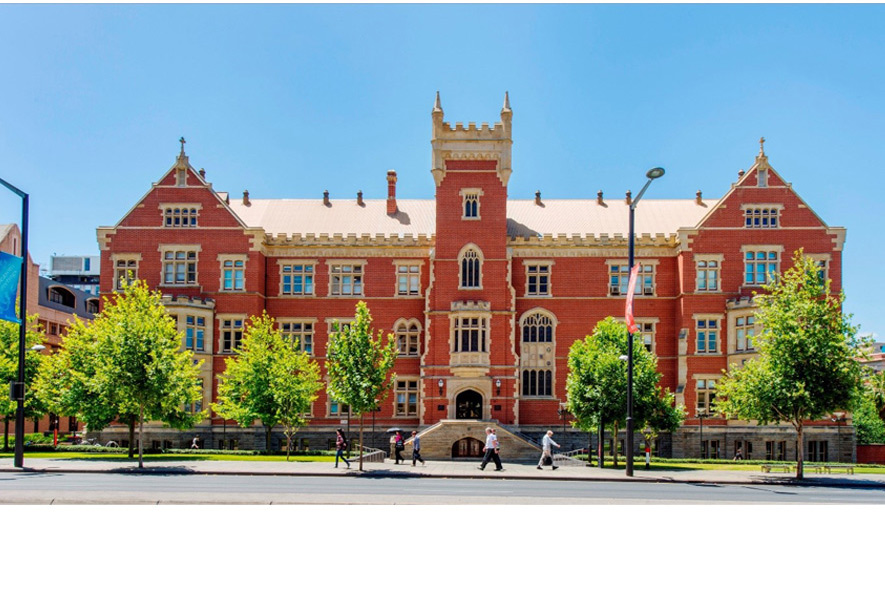
In November 2004, Eynesbury College and SAIBT were amalgamated with other IBT colleges in Australia and overseas, to become part of IBT Education Ltd.
On 15 December 2004, IBT Education became Australia’s first publicly listed Higher Education company to be floated on the ASX (Australian Securities Exchange).
In 2007, IBT Education changed its name to Navitas Ltd.
At the end of 2007, Dr Tony Stimson retired from his position as Principal, and later as a member of Council of Eynesbury Senior College Inc.
In 2009, Eynesbury celebrated its twentieth birthday, with the opening of a new and second campus, located in Coglin Street, Adelaide. Eynesbury’s Foundation, Diploma and English language programs were thereafter predominantly delivered at the Coglin Street campus.
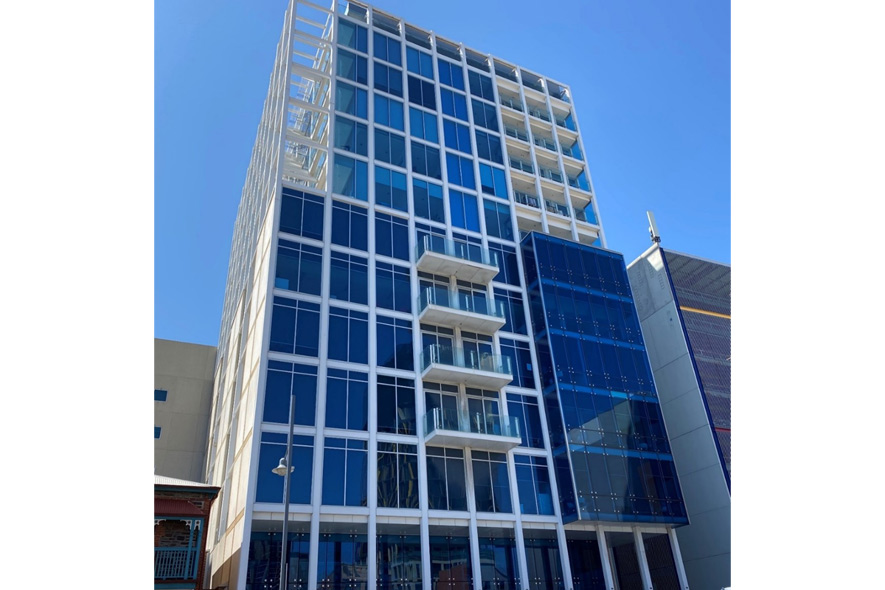
In August 2018, Malcolm Raedel retired from his position as Executive General Manager, Navitas Ltd, Australia, Asia and Africa, University Programs Division and as member of Council of Eynesbury Senior College Inc.
In November 2021, the affiliated senior secondary schools for domestic and international students were closed, amidst ongoing financial fall-out from the Covid pandemic.
In October 2023, the proposed merger between the University of Adelaide and the University of South (UniSA) was passed by the South Australian Parliament. The joint institution, to be known as “Adelaide University”, will become one of the largest tertiary education providers in the country, to begin operations in January 2026.
At the time of the second anniversary of closure of the senior secondary schools of Eynesbury Senior College and Eynesbury College, Eynesbury College enters a new phase in its history, secure in the record of achievement of the secondary school from which it evolved, and the wider contribution to innovation in secondary and tertiary education, of which it has been an integral part.
Malcolm Raedel is a former High School teacher; Lecturer in Economics, Geography and Accounting with Adult Matriculation, TAFE (Department of Technical and Further Education); Lecturer in International Economics at the South Australian College of Advanced Education (SACAE) /University of South Australia (UniSA); Co-Founder of Eynesbury College; Director, Educational Enterprises Pty Ltd; Co-Director and Co-Principal of Eynesbury College; Teacher in Economics and Accounting at Eynesbury College; Managing Director, Educational Enterprises Pty Ltd trading as Eynesbury College; Co-Founder of Eynesbury Institute of Business and Technology (EIBT); Managing Director of Educational Enterprises Pty Ltd, trading as Eynesbury Institute of Business & Technology; Director, Centre for Applied Linguistics in the University of South Australia; Director, China Australia Language College Pty Ltd; Managing Director, Eynesbury Education Group; Director and Principal, Eynesbury International; General Manager, Eynesbury International; Director, South Australian Institute of Business & Technology (SAIBT); Executive Director/Principal, SAIBT; Managing Director IBT Education Ltd: Eynesbury International, South Australian Institute of Business & Technology (SAIBT), and Centre for English Language in the University of South Australia (CELUSA); General Manager, Navitas Ltd, University Programs Division; Executive General Manager, Navitas Ltd, Australia, Asia & Africa, University Programs Division; and Non-Executive Director, Camino Global Education Pty Ltd.